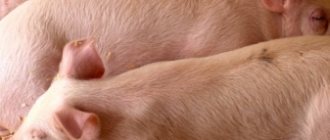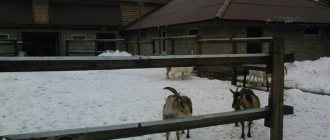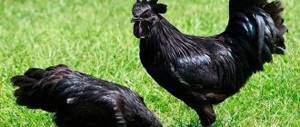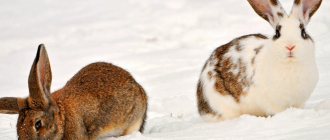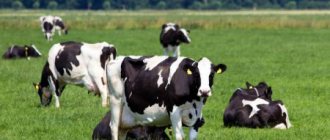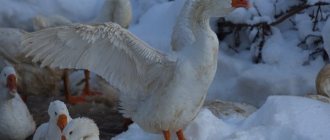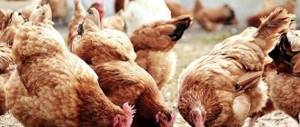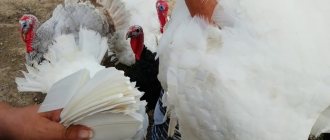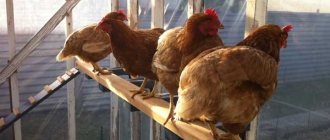Habits of a roe deer in winter
Roe deer are similar in appearance to small deer, to which they belong. Males have small horns, females do not have them. In our country, these animals grow up to 80 cm in height and weigh up to 30 kg. They feed on grass, cereals, buds and shoots of trees and shrubs, less often pine needles, but they do not eat bark. Their main senses are smell and hearing; their eyesight is poor.
One of the most striking features in the behavior of this ungulate is caution, one might say excessive. Roe deer are always wary, whether feeding or resting. They are always looking for danger, turning their heads, listening, moving their ears; if they are in a herd, then at least two-thirds of its number is on guard at the same time. Hearing a suspicious sound, the roe deer immediately freezes, often in a very uncomfortable position; if it was moving at that time, it stops. If these ungulates discover some suspicious object, they try to go around it and find themselves on the leeward side of it.
Healthy! Roe deer have this peculiarity of behavior: during fattening, as if provoking a predator, it slowly lowers its head to the ground, as if feeding, and then sharply raises it, trying to catch the movement of a potential enemy.
By winter, roe deer gather in small herds. Their activity time is reduced compared to summer. They go out to feed from three to six times a day, usually during the twilight period. Animals lie down between fat areas, choosing safe places that allow them to control the space far away. Usually these are the edges of forests or the outskirts of clearings, under young trees and bushes. They go deep into the forest only in severe bad weather.
The roe deer lay down not far from each other and try to position themselves so as to look in different directions and monitor the entire surrounding space. Alone, the goat tries to lie with its back to the wind so that the danger behind can be controlled by smell, and in front by hearing and sight.
If during fattening these animals move in small steps, and when moving calmly at a trot, then in case of danger they break into huge leaps reaching 10 m in length and 2 m in height, although they can run like this for no more than eight minutes.
All these behavioral features make roe deer hunting very exciting.
Hunting by season
The exact dates for the general beginning and end of hunting for deer species are discussed above. Here we will look at hunting for three main seasons:
in autumn
After the mating season of roe deer, from early summer to mid-autumn, some males die in mating fights, and some spend a significant part of their male energy on processing females. Roe deer flock together and try to stay together at all times. But overly tired males are clearly visible in such an animal society. At the end of autumn there is already snow in many places. However, herds of deer try to find food in snowless clearings of fields or clearings. It is in such places that the most successful option is to conduct autumn hunting, sneaking up to them in weather with light drizzle and light wind. It’s good if the catcher uses optics and a shot silencer. The described weather conditions can weaken the acute senses of hearing and smell of roe deer, thereby preventing them from being spooked for hunting purposes.
in winter
Winter is a great time for many types of roe deer hunting. To do this, determine the exact habitat of the roe deer flock and hide nearby.
In cold weather, there is very little food freely available; you have to spend a significant amount of time searching for it. Tearing up snow drifts in search of food resources weakens the animal's attention and safety. In winter, the deer family experiences general slowness and weakness due to lack of nutrition and disruption of its continuity.
If a hunter follows all the known rules and laws prescribed for winter fishing, success in his hunt for roe deer is practically guaranteed.
in spring
A “good” hunter will not choose the spring period to hunt a wild goat himself. There are simply no trails or chains of tracks in the spring. Dirt and cold are not particularly pleasant to endure during this period. Hunting regulations during this period prohibit the fishing of the Siberian species of roe deer. In other regions, fishing is under strict control by rangers in connection with the birth and upbringing of the offspring of deer species.
Hunting preparation
Preparing for a winter hunt for roe deer from the approach requires a preliminary inspection of the future hunting sites, searching for tracks and bedding areas of the animals. Selection of certain clothes, equipment, weapons and ammunition.
Selecting a location
One of the keys to successful roe deer hunting in winter is scouting the future hunting area and searching for animals. During the inspection of the area, it is necessary to find their traces and from them try to detect the wild goats themselves, their bedding and feeding areas. By examining the tracks, you can determine the direction and nature of movement of these ungulates.
Roe deer tracks
So, if the track is winding, the distance between the tracks is small and there are a lot of tracks, then this is a feeding place, there is an opportunity to meet animals on the fat.
Familiarize yourself with the features of hunting elk from the approach.
If the tracks are deep and the distance between them is large, it means that the roe deer was fleeing, such a track does not need to be tracked. Uniform, even tracks with moderate intervals indicate that the animals were moving to a resting place to rest. In resting areas, they rake snow and litter almost to the ground, and remove pebbles and cones from the hole.
Roe deer roosting area
When laying down in the hole, they bend their legs and press their heads to their chest, so the beds may seem very small. Often feeding and resting areas are located close to each other.
All this helps to first find out the most likely places where roe deer will appear, so that the next day you can try to sneak up on them for hunting.
Clothing and equipment
The peculiarities of the habits and caution of the roe deer, the method of hunting and winter conditions impose certain requirements on the equipment for such a hunt:
- you should move quietly, clothes and equipment should not rustle, rustle or creak; things made of cotton or wool are best suited for this; The best way to get around is on skis
- since hunting from the approach involves quite a lot of movement, you should not be dressed excessively warmly, otherwise you can give yourself away with steam and smell, it is better to take a spare sweater in your backpack;
- such a hunt requires camouflage; winter camouflage or camouflage clothing will help with this; in extreme cases, clothing should be black and gray;
- shoes should be warm and comfortable; in this regard, boots using membrane materials such as Gore-Tex have performed well;
- It’s better to move around on skis, it’s much faster, easier and quieter;
- In order to look out for animals at a great distance, binoculars are useful;
- As for the dog, you should take only a specially trained and prepared dog for such a hunt, otherwise it will completely ruin your hunt.
Weapons and ammunition
According to the hunting rules, you cannot shoot at a roe deer with shot or buckshot with a diameter of less than 5 mm in order to avoid wounded animals.
As a rule, smooth-bore weapons involve shooting at close ranges, and rifled weapons at long ranges. The roe deer is a very cautious animal, and it is quite difficult to get within shooting range of it. Therefore, a lot depends on your hunting skills and preferences.
Smooth-bore weapons must have a long barrel no shorter than 550 mm. This will allow us to talk about at least some accuracy at the required distances. They shoot with 0000 shot or buckshot from 5 to 6.8 mm.
Roe deer hunting with a double-barreled shotgun
Of course, rifled weapons are more suitable for such hunting . It is better, of course, to use a caliber of 7.62 mm, but 5.6 mm will also cope with this task, although the stopping effect of such bullets will be less.
Therefore, if your skills allow you to get close enough to these wary animals for a close enough shot, then you can use a smoothbore, semi-automatic shotgun with a long barrel. A much better option would be to use a combination weapon, with smooth and rifled barrels. It is most practical to use a gun, a semi-automatic one, with a rifled barrel, with a diameter of 5.6 mm, and preferably with an optical sight.
Requirements for hunting equipment
Hunting in winter is complicated by low temperatures. Clothes should be selected so that they are warm enough, but not too warm. When you move in overly insulated clothing, it will become hot, and the steam coming from you can cause animals to notice you and get scared. Alternatively, pack a spare sweater in your backpack.
The most suitable fabric for clothing is soft cotton or wool, which does not make noise when moving. Color – blends with the environment, white is best in winter.
Shoes are warm and comfortable. In order to move silently, it is better to ski, if possible.
How to hunt roe deer, process
The process of approach hunting itself is simple in its essence, but it requires knowing and taking into account a lot of features and nuances, as well as developing certain skills, such as silent movement.
How to track and approach
There are two ways to hunt roe deer in winter from the approach: by tracking and directly in explored places. In the first case, the hunter begins to track the animals, during the tracking process he finds them and, carefully creeping up, shoots. In the second case, he finds out in advance, taking into account the terrain, by tracks and visual observation, their possible location, bedding and feeding areas, and the next day he hunts there from the approach.
In both cases, for a successful hunt, a number of rules and conditions must be observed:
- For hunting, it is better to choose a cloudy and windy day; on such days it is easier to approach a roe deer. You need to go out before dark, good visibility will benefit you first of all.
- Before you start, check your gun and loads, you must be ready to open fire at any time.
- It is better to start searching in the open forest or along the edges, carefully inspect the territory.
- You need to move carefully, slowly and silently; while carefully examining the area, it is better not to move.
Important! You should always approach roe deer against the wind, so they won’t smell you and will hear you less.
- When tracking, you do not need to follow the trampled trail directly; these animals always monitor the space along their trail with special attention; they will smell you and run away. You need to move in a zigzag manner, periodically crossing the trail at right angles.
- A single animal behaves more cautiously than a group. It is better to track a small herd, this will increase your chances.
Healthy! During feeding, roe deer spend more than half of their time monitoring their environment.
- If a branch cracks under you while tracking, you need to freeze for 10 minutes so that the animals calm down.
- The same thing needs to be done if the roe deer turns its head towards you, most likely it caught the movement and did not notice you, its eyesight is not very good.
- You need to shoot only when you are sure of the shot, there is no need to rush.
- Sensing danger, the roe deer immediately makes several jumps, and then stops to find out the source of the danger; at these moments you need to have time to shoot.
- By tracking a group and killing one animal, you can follow the trail of others, who may pause, waiting for a relative.
About roe deer
The roe deer is the smallest representative of the deer family. The roe deer grows to a height of 75-85 cm, with a body length of 170-180 cm and an average weight of 25-30 kg.
Roe deer have poor eyesight, but their hearing and sense of smell are very well developed. A frightened roe deer can reach speeds of up to 65 km/h, while making jumps up to 10 meters long.
Roe deer have red fur in summer and grey-red in winter.
There are two types of roe deer in Russia: European and Siberian roe deer. The two types of roe deer do not differ from each other in the color of their fur, but the Siberian roe deer is much larger. A male Siberian roe deer is almost twice as large, its weight can reach 60 kg.
Hunting for roe deer on salt licks
Hunting for roe deer on salt licks is a variation of the method of hunting roe deer from ambush. Roe deer, like other ungulates, experience a lack of salt. Hunters set up artificial feeders with salt in suitable places. Not far from the salt lick, a storage shed or shelter is set up.
Roe deer most regularly visit salt licks in the summer; this is the best time for hunting in salt licks; it is in the summer that roe deer experience the maximum need for salt. A salt feeder is made from fallen aspen, in the upper part of which a crack is cut out with an ax into which salt is poured. Another option for making a salt feeder is to make it from an aspen log, which is placed on two stumps and salt is poured on top. The salt feeder should be comfortable for roe deer so that they can lick the salt in a natural position for them and at the same time have the opportunity to inspect the area around them. Roe deer love to visit salt licks located near watering places and feeding areas.
Not far from the salt lick, blind spots are set up; most often there are at least two of them, so that you can choose one of them, taking into account the direction of the wind on the day of the hunt. The blinds are made on trees with a dense crown so that the roe deer cannot see the hunter. The blind should be located at a height of 3-4 meters from the surface of the earth, then the roe deer will not be able to smell the hunter, in addition, the hunter will be able to see the roe deer from a greater distance.
Hunting with decoy
Hunting for roe deer with a decoy is the most interesting way of hunting for roe deer, which is used by hunters with extensive experience in hunting ungulates.
The hunter scouts in advance the places where a fairly large number of roe deer live. It is best to start hunting early in the morning. The hunter walks around the places where roe deer are supposed to live and makes stops to lure the roe deer with a decoy. When luring a roe deer with a decoy, you should not immediately lure with loud sounds, you need to start luring with quieter sounds, gradually increase the volume. It is better to repeat alluring sounds at intervals of 10-15 minutes. A pause in the lure is needed to give the roe deer time to approach the hunter and not scare them away. If the roe deer do not appear, you need to change the place and continue attracting there.
Roe deer hunting with a decoy is especially effective during the roe deer rut. This period lasts from July to the end of August. Rutting areas can be determined by the traces that males leave on the ground in the process of pursuing a female: ruts, trampled circles and areas. In the first half of the rut, you need to use the voice of a young female, in the second half, towards the end of August, you need to attract roe deer with the voice of an old female. At the beginning of the rut, hunting is less effective, but as most females are fertilized, male roe deer are more and more willing to follow the sound of a decoy and by the end of the rut, hunting becomes more and more effective. Young male roe deer are especially active in responding to the sound of a decoy; more experienced males behave more cautiously and are not so easy to deceive. Sometimes the female roe deer first approaches the sound of the decoy, and only then the male comes running after her.
Hunting for roe deer with a decoy can be carried out not only during the roe deer rut, but throughout the year, although it will not be as effective. Roe deer use various sounds for communication all year round: females whistle to call their calves, hungry cubs call their mother to feed them, roe deer have special sounds with which they notify their herd of danger. A hunter can imitate the sounds of roe deer using a decoy in order to lure them within shooting range. When hunting roe deer with a decoy, it is advisable to use a high-quality purchased decoy, although some hunters with extensive hunting experience make such decoys themselves, and homemade decoys made by an understanding craftsman are not inferior in sound quality to purchased decoys.
The only way to learn how to properly attract roe deer with a decoy is practice. The hunter finds roe deer grazing and begins to attract them with a decoy. Then, based on the behavior of the roe deer, he determines whether he is doing everything correctly: if the roe deer are hiding, then he is doing something wrong, and if the roe deer remain in place and begin to come closer to the hunter, then the hunter is doing everything correctly. By constantly practicing how to attract roe deer, the hunter will soon be able to become a real professional.

